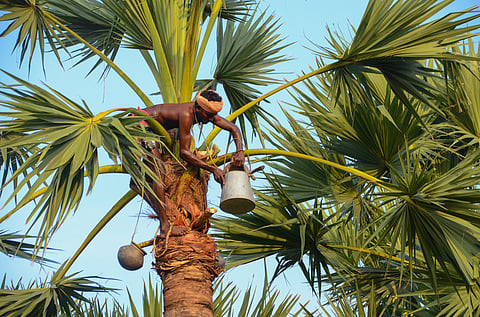Climate change: Palm juice production dips due to heat waves, low rainfall
THOOTHUKUDI: Owing to various factors, there has been a substantial reduction in the extraction of palmyra juice (locally known as pathaneer) in the district. While researchers of the tree species attribute the poor yield to the vagaries of climate change, palm tree climbers say that low rainfall during the last summer could have aggravated the situation.
According to sources, pathaneer sale remains a common sight along the roads across Tamil Nadu, particularly during the summers. As the season sets in, tappers hone the inflorescence of the palmyra trees and collect the pathaneer, which oozes out, into mud pots. The inner surface of the pots will be coated with lime to prevent fermenting of the raw sap.
It may be noted that pathaneer is a natural drink, which generates good remuneration for the palmyra tappers during the tapping season (March - August/September). The collected saps are also boiled and used by the women of the tappers' families to make palm jaggery, which is of high demand in the market.
Speaking to TNIE, Siluvai Anthony of Anthoniarpuram said, "The extraction of palm juice has been very low since the tapping season began in mid-March this year. A palmyra tree, which normally yields six or seven padis, is now generating only three padis resulting in very low yield this season," he said, adding that one padi equals 1.5 litre.
He further said that the size of the inflorescence that yields pathaneer looks small, maybe due to poor rainfall last summer season. "The spikes, which were formed during the previous summer, are now emerging out of the crest after 10 months. However, these did not attain proper growth due to low rainfall," he added.
Whereas, another climber opined that the spikes are yet to come out as they are unhealthy. "Generally, palm climbers require a good spell of rain for a good yield. With very low pathaneer extraction, the production of palm jaggeries also gets adversely affected," he said.
According to researchers, a full grown young female palmyra tree could secrete 12 litres of pathaneer per day in a normal season, while the male ones secrete a little less than the female trees. However, as stated by the members of Anthoniyarpuram palm juice shandy, which contributes its remuneration to an RC diocese school, they have been receiving only 70 litres of palm juice per day, as against the usual arrival of 200 plus litres. "The reduction in palm juice has substantially hindered the revenue generation for the school as well," added a member.
Meanwhile, Yakobu Raj, a palmyra climber from Sathankulam, who has been cutting the inflorescence for the past one month, said, "Nowadays, I am able to collect only two pots of pathaneer, which hardly amounts to four litres. The quantity of the sap has been halved, as otherwise each tree in the region would have yielded nearly eight litres or four pots."
Speaking to TNIE, VOC Agriculture College and Research Institute (ACRI) Killikulam, Horticulture department Palmyra Research Chief Scientist Dr N Richard Kennedy said that the yield of palmyra sap has dropped drastically in the past 10 days, owing to the prevailing heat waves. These waves, which are different from rise in temperature, are an unusual phenomenon, he said, hinting at climate change.
In addition, the rise in temperature could have also reduced the yield, he said, and added that the pathaneer extraction from the observatory trees of Killikulam campus also reduced substantially in the past 10 days, after the heat waves began in the region.
Furthermore, Kennedy said that there has been an unidentified disease spreading among palmyra trees, causing shedding of leaves in large numbers. "A survey is underway in this regard, but it's too early to comment anything," he said and also endorsed the farmers' view of low rainfall affecting the extraction.

